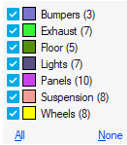Create or Update Classifiers and Labels
Part label information must be provided to successfully train a machine learning model. Use the Classifier: Label tool to create classifiers and labels, which can be assigned to parts later.
View new features for HyperMesh 2022.3.
Learn the basics and discover the workspace.
Discover HyperMesh functionality with interactive tutorials.
Solver interfaces supported in HyperMesh.
A solver interface is made up of a template and a FE-input reader.
Support provided by the CAD readers and writers.
Browsers supply a great deal of view-related functionality by listing the parts of a model in a tabular and/or tree-based format, and providing controls inside the table that allow you to alter the display of model parts.
Panels contains pre-processing and post-processing tools.
Create, edit, and cleanup geometry.
Different types of mesh you can create in HyperWorks.
Create connections between parts of your model.
Create, organize and manage parts and subsystems.
Also referred to as Postgres, PostgreSQL is an object-relational database management system with emphasis on extensibility and standards compliance.
Use the automotive section library for rapid concept development in the early phases of the vehicle design process.
Use the Organize tool to move or copy entities into their proper destinations.
Automatically group selected parts into part sets based on comparison method and criteria selected.
Set up and use machine learning (ML) models to automatically classify parts under user-defined labels and into part sets.
Part label information must be provided to successfully train a machine learning model. Use the Classifier: Label tool to create classifiers and labels, which can be assigned to parts later.
Train a machine learning model based on labeling information it contains.
Classify parts by predicting their label and creating part sets.
Use the Renumber tool to review and organize the IDs of model entities.
Change the order of named entities in database.
Manage all of the IDs for the entities that you create, and define ID ranges for all of the entities in each Include file in relation to the full model in order to avoid ID duplication.
Scenarios are a mechanism to apply controls to engineering entities.
Create and articulate a kinematic mechanism based on FE mesh using the Mechanism Browser.
Perform automatic checks on CAD models, and identify potential issues with geometry that may slow down the meshing process using the Verification and Comparison tools.
Local coordinate systems can be used for setting up loads/boundary conditions that do not act in the global axis direction, transforming results, defining material orientation, and many other operations.
Define vectors in 3D space.
Define physical and mathematical characteristics of parts.
Use the Auto Contacts tool to determine contact interfaces between selections of components or elements. Based on the user-specified options like proximity tolerance, surface creation method, main surface type, and secondary type, the tool generates contacts based on set segments or node and element combinations.
Create, review, and edit RBE2/RBE3 elements and MPC equations.
Use the curve editor to create and plot XY curves.
The Abaqus solver offers the flexibility of modeling rigids as surfaces using primitive geometry.
Perform automatic checks on CAD models, and identify potential issues with geometry that may slow down the meshing process using the Verification and Comparison tools.
Tools used for crash and safety analysis.
HyperMesh composites modeling.
Overview of how to build a finite element model.
Morph the shape of your finite element model.
Setup an Optimization in HyperMesh.
Convert finite element models to another solver format.
Study relationships between data vectors in results files.
Learn how to use post-processing functions.
Create, organize and manage parts and subsystems.
Set up and use machine learning (ML) models to automatically classify parts under user-defined labels and into part sets.
Part label information must be provided to successfully train a machine learning model. Use the Classifier: Label tool to create classifiers and labels, which can be assigned to parts later.
Part label information must be provided to successfully train a machine learning model. Use the Classifier: Label tool to create classifiers and labels, which can be assigned to parts later.

If you assign more than one label to a single part concurrently, you are prompted to remove the existing label from the part and assign to it the new one.

© 2023 Altair Engineering, Inc. All Rights Reserved.
Intellectual Property Rights Notice | Technical Support | Cookie Consent